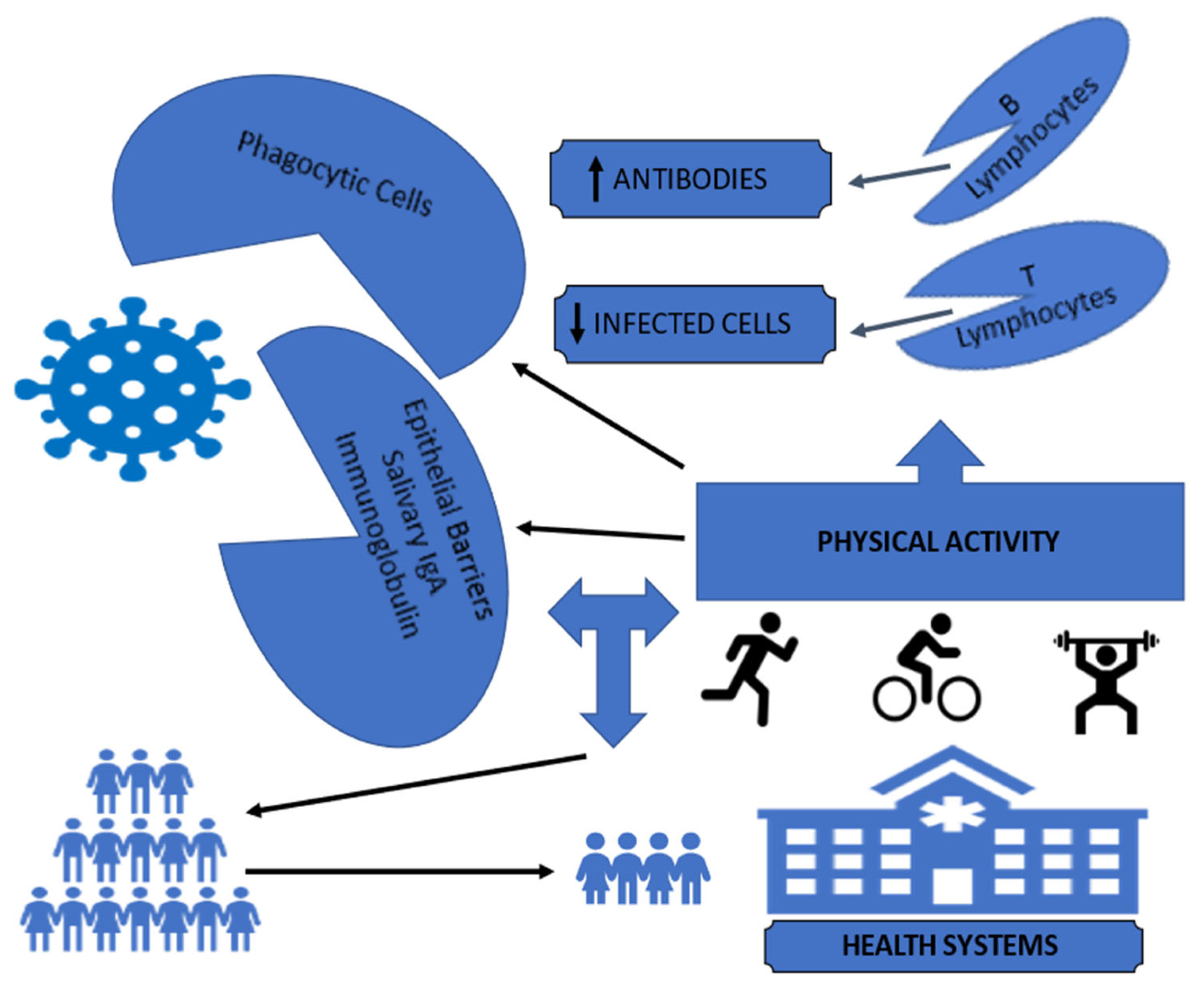Physical Activity, Empowerment of the Immune System and Public Health: What We Learned from the COVID-19 Pandemic
Conflicts of Interest
References
- Sallis, J.F.; Pratt, M. Multiple benefits of physical activity during the Coronavirus pandemic. Rev. Bras. Ativ. Fís. Saúde 2020, 25, e0112. [Google Scholar] [CrossRef]
- Pitanga, F.J.G.; Beck, C.C.; Pitanga, C.P.S.; Pinho CSCortez, A.C.L.; Guedes, D.P.; Matsudo, V.K.R. Association between leisure time physical activity and mortality by Covid-19 in the brazilian capitals: An ecological analysis. Rev. Bras. Med. Esporte 2021, 27, 573–577. [Google Scholar] [CrossRef]
- Sallis, R.; Young, D.R.; Tartof, S.Y.; Sallis, J.F.; Sall, J.; Li, Q.; Smith, G.N.; Cohen, D.A. Physical inactivity is associated with a higher risk for severe COVID-19 outcomes: A study in 48 440 adult patients. Br. J. Sports Med. 2021, 55, 1099–1105. [Google Scholar] [CrossRef] [PubMed]
- Lee, S.W.; Lee, J.; Moon, S.Y.; Jin, H.Y.; Yang, J.M.; Ogino, S.; Song, M.; Hong, S.H.; Abou Ghayda, R.; Kronbichler, A.; et al. Physical activity and the risk of SARS-CoV-2 infection, severe COVID-19 illness and COVID-19 related mortality in South Korea: A nationwide cohort study. Br. J. Sports Med. 2021, 56, 901–912. [Google Scholar] [CrossRef] [PubMed]
- Ezzatvar, Y.; Ramírez-Vélez, R.; Izquierdo, M.; Garcia-Hermoso, A. Physical activity and risk of infection, severity and mortality of COVID-19: A systematic review and non-linear dose-response meta-analysis of data from 1 853 610 adults. Br. J. Sports Med. 2022, 56, 1188–1193. [Google Scholar] [CrossRef] [PubMed]
- Chastin, S.F.M.; Abaraogu, U.; Bourgois, J.G.; Dall, P.M.; Darnborough, J.; Duncan, E.; Dumortier, J.; Pavón, D.J.; McParland, J.; Roberts, N.J.; et al. Effects of Regular Physical Activity on the Immune System, Vaccination and Risk of Community-Acquired Infectious Disease in the General Population: Systematic Review and Meta-Analysis. Sports Med. 2021, 51, 1673–1686. [Google Scholar] [CrossRef] [PubMed]
- Klentrou, P.; Cieslak, T.; Macneil, M.; Vintinner, A.; Plyley, M. Effect of moderate exercise on salivary immunoglobulin A and infection risk in humans. Eur. J. Appl. Physiol. 2002, 87, 153–158. [Google Scholar] [CrossRef] [PubMed]
- Shimizu, K.; Kimura, F.; Akimoto, T.; Akama, T.; Otsuki, T.; Nishijima, T.; Kuno, S.; Kono, I. Effects of exercise, age and gender on salivary secretory immunoglobulin A in elderly individuals. Exerc. Immunol. Rev. 2007, 13, 55–66. [Google Scholar] [PubMed]
- Tada, A.; Senpuku, H. The Impact of Oral Health on Respiratory Viral Infection. Dent. J. 2021, 9, 43. [Google Scholar] [CrossRef] [PubMed]

Publisher’s Note: MDPI stays neutral with regard to jurisdictional claims in published maps and institutional affiliations. |
© 2022 by the author. Licensee MDPI, Basel, Switzerland. This article is an open access article distributed under the terms and conditions of the Creative Commons Attribution (CC BY) license (https://creativecommons.org/licenses/by/4.0/).
Share and Cite
Pitanga, F.J.G. Physical Activity, Empowerment of the Immune System and Public Health: What We Learned from the COVID-19 Pandemic. Int. J. Environ. Res. Public Health 2022, 19, 13837. https://doi.org/10.3390/ijerph192113837
Pitanga FJG. Physical Activity, Empowerment of the Immune System and Public Health: What We Learned from the COVID-19 Pandemic. International Journal of Environmental Research and Public Health. 2022; 19(21):13837. https://doi.org/10.3390/ijerph192113837
Chicago/Turabian StylePitanga, Francisco José Gondim. 2022. "Physical Activity, Empowerment of the Immune System and Public Health: What We Learned from the COVID-19 Pandemic" International Journal of Environmental Research and Public Health 19, no. 21: 13837. https://doi.org/10.3390/ijerph192113837
APA StylePitanga, F. J. G. (2022). Physical Activity, Empowerment of the Immune System and Public Health: What We Learned from the COVID-19 Pandemic. International Journal of Environmental Research and Public Health, 19(21), 13837. https://doi.org/10.3390/ijerph192113837




